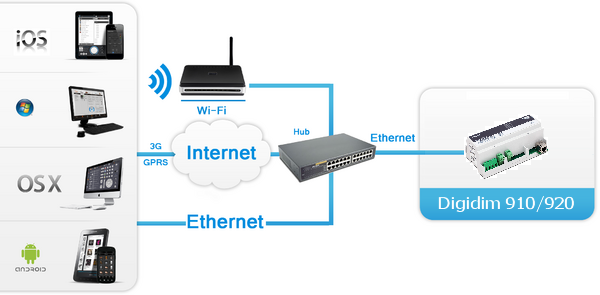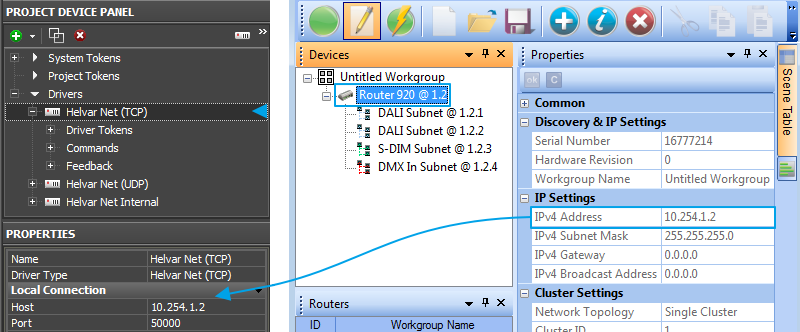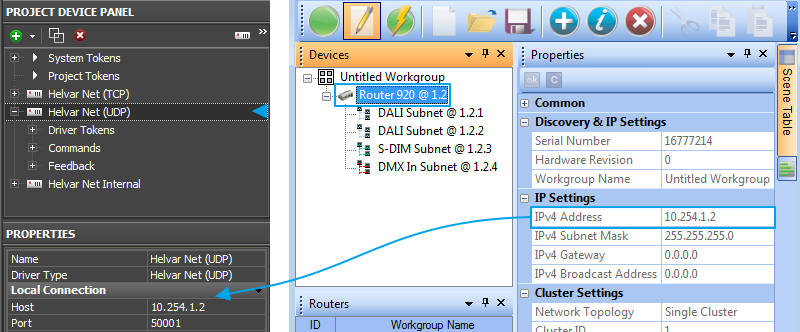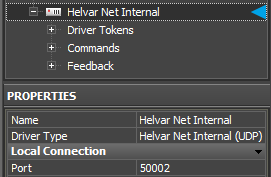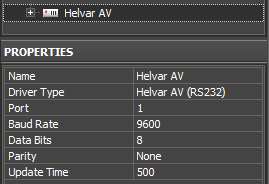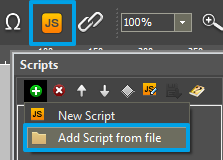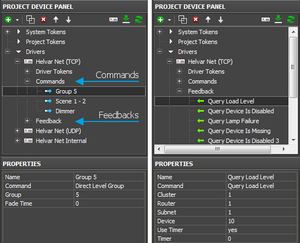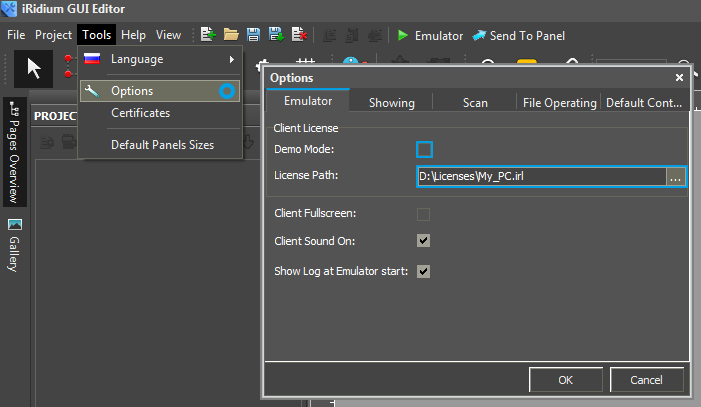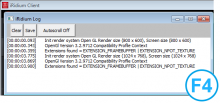Setting up Communication with Helvar
Contents
How it Works
To connect iRidium App to Helvar equipment HelvarNet (TCP or UDP), HelvarNet Internal (UDP) or Helvar AV (RS232) protocols are used.
It is possible to send or receive data only if the control device and the IP interface of connection to Helvar are in one IP subnetwork.
Topology of connecting iRidium App to Helvar equipment via an IP interface:
Required license: "Device License for Helvar" or "Site License for Helvar" (see Licensing).
- "Device License for Helvar" - it can be used with any way of connection to Helvar
- "Site License for Helvar" - it can be used working by HelvarNet (TCP and UDP) only. The HelvarNet Internal and Helvar AV protocols do not support Site licensing.
Ways of Connection to the Helvar System
Connection to Helvar routers (Digidim 910 Router, Imagine 920 Router) is possible via several protocols:
Make sure your Helvar router supports the HelvarNet protocol. If this protocol is not supported you need to update your software and firmware.
HelvarNet (TCP) Protocol
The protocol supports Site licensing for Helvar (see Licensing)
HelvarNet (TCP) is the Ethernet I/O protocol providing two-way data exchange with Helvar routers. It enables update of the device status by the client request only and provides possibility of connection of the control device from the local network and the Internet. Only one iRidium App using the HelvarNet (TCP) protocol can be connected to the router at a time. The router IP-address in the IPv4 standard is used for its identification.
Characteristics:
- updating states of devices and scenes only by the client request
- one connection of the control device at a time
- connection from the local network and via the Internet
Properties of connection to the router via the HelvarNet (TCP) protocol:
- Host – the IP-address in the local network (or public IP-address of the router)
- Port – the ТСР port of connection to the router. For HelvarNet (TCP) it is always 50000.
For working with the controller via the Internet indicate the public IP-address of the router the controller is connected to in the connection settings. Port Forwarding Service is set up for the router to enable remote control – referring to the local (private) address of the controlled controller from the Internet.
You can learn the external (public) IP-address of your router with the help of external resources, for example [1]
HelvarNet (UDP) Protocol
The protocol supports Site licensing for Helvar (see Licensing)
HelvarNet (UDP) is the protocol for controlling the state of devices in the Helvar system. It enables request of the bus for receiving the status of devices and scenes. Changes are processed only if they are made by the client. Connection via the Internet using HelvarNet (UDP) is not possible. Several iRidium Apps can be connected to the router at a time.
Characteristics:
- updating states of devices and scenes only by the client request
- simultaneous connection of several control devices
- connection only from the local network
Properties of connection to the router via the HelvarNet (UDP) protocol:
- Host - the IP-address in the local network
- Port - the UDP port of connection to the router. For HelvarNet (UDP) it is always 50001
HelvarNet Internal (UDP) Protocol
The protocol does not support Site licensing for Helvar (see Licensing)
HelvarNet Internal (UDP) – протокол, использующий широковещание (broadcasting) в пределах одного сегмента IP-сети. Таким образом, число подключенных клиентов не ограничивается, доступно слежение за командами сети, изменениями состояний, без принудительного запроса данных. Невозможно подключение клиентов через Интернет.
Characteristics:
- updating states of devices and scenes only automatically (without the client request)
- simultaneous connection of several control devices
- connection from the local network only
Properties of connection to the router via the HelvarNet Internal (UDP) protocol:
- Port – the UDP port of connection to the router. For HelvarNet Internal (UDP) it is always 50002
Helvar AV (RS232) Protocol
The protocol does not support Site licensing for Helvar (see Licensing)
Connection to the DIGIDIM system via the Digidim 503AV interface (Audio-Video interface which allows you to connect the DIGIDIM system to the RS232 port of external devices) is made via the Helvar AV protocol.
Helvar AV (RS232) enables controlling of the DALI machine, requesting the state of devices, processing data about changing the state of the bus devices. It is impossible to work via the Internet and connect more than 1 client at a time.
Properties of connection to the router via the Helvar AV (RS232) protocol:
- Port – the number of the СОМ port of the PC the Digidim 503AV interface is connected to
- Baud Rate – speed of exchanging data with the interface
- Data Bits – the number of information bits in ta frame
- Parity – parity control
- Update Time (мс) – frequency of data update
Switching Between the Local and Internet Connection
If the control panel should hold the connection with the system when the panel is out of the limits of the Wi-Fi network of the system, you need to set up the switch between the Internet and the local network.
The remote mode suggests connection to the system via the Internet. At that the external IP-address or the domain name of the system to which you need to connect have to be used.
 In iRidium Wi-Fi/3G CANNOT be switched automatically. For switching between the Internet and the local network you need buttons with special settings. See the settings below.
In iRidium Wi-Fi/3G CANNOT be switched automatically. For switching between the Internet and the local network you need buttons with special settings. See the settings below.
 To control the system remotely you have to open the system for external access -
To control the system remotely you have to open the system for external access -
to set up the Port Forwarding Service.
 To secure equipment from unauthorized access we recommend using secure connection with the remote system (VPN).
To secure equipment from unauthorized access we recommend using secure connection with the remote system (VPN).
Setting up of the switch Wi-Fi/3G in iRidium projects:
1. Open the script editor in iRidium GUI Editor.
2. Download and add into your project the template of the Wi-Fi/3G switch (Add Script from file):
download the template of the Wi-Fi/3G switch
The Wi-Fi/3G switch is performed with the help of the script function SetParameters
Setting up of parameters of the Wi-Fi/3G switch:
- function Internal_1() // Function name
- {
- IR.GetDevice('Helvar Net (TCP)').SetParameters({Host: '192.168.0.100', Port: '50000'}); // Driver Name + Parameters
- }
- function External_1()
- {
- IR.GetDevice('Helvar Net (TCP)').SetParameters({Host: '220.115.10.10', Port: '50000'});
- }
Indicate in the command settings:
- Function name – the name of the switch function (command). Two functions cannot have the same name in a project.
- Driver Name – the name of the driver which parameters are changed
- Parameters – the set of the switch parameters which you need to apply to the driver
Assign commands to buttons:
- Select the button which will be responsible for the Wi-Fi/3G switch.
Open the properties of the button: Object Properties > Programming - Open Macros Editor of the button for the Press or Release events
- Select the Script Call command and add it by double-clicking on it
- Select the name of the function you want to activate in the drop-down list. Create the command.
Set up access to the equipment from the Internet:
In order to do that open the equipment ports for remote access.
Download the example of the Wi-Fi/3G switch (project) >>
Principles of Sending Commands to Helvar
To send commands and receive data about the state of equipment in the bus the Helvar driver has 2 tabs:
- Commands – commands for setting up values of controlled devices
- Feedbacks – channels receiving feedback from controlled devices
You can control separate devices or groups of devices in the Helvar system. It is defined by commands set up in iRidium GUI Editor. The list of the available commands is in the drop-down list shown at the command setting up.
Several drivers are often used in one project to cover the system functionality (several clients, status requests, monitoring of changes in the system, work via the Internet).
Emulation of Project Work
Emulator
- is an iRidium application for Windows which can be launched from GUI Editor for testing your projects. Emulator can work both with a license (with connection to the equipment) and without it (when only the project graphic part is functional).
Operation modes for Emulator (see GUI Editor > Tools > Options > Emulator):
- Without the license (Demo Mode: on) – no connection with the controlled equipment.
- With the license (License Path: [...]) – when the license file is selected, all Emulator functions work and there is connection with the controlled equipment.
Indicate the path to the license file for Emulator (GUI Editor > Tools > Options > Emulator):
* When Demo Mode is activated Gui Editor won’t show the message about starting without the connection to the controlled equipment (without a license). Check if there is a license when setting up your project.
Emulator hot keys
- Click F5 to start Emulator.
- Click F8 to open the Emulator settings (password: 2007)
- Click F4 to open the Emulator log.
| For fully functional work of iRidium on your PC it is required to get an iRidium license and activate it for for your PC. Activation of licenses for iPad/iPhone/Mac/Android based or other devices does NOT lead to the automatic licensing of the PC with the installed iRidium Environment. A license for your PC is required for iRidium client on your PC (including Emulator) to work in the fully functional mode. The license should be purchased separately or you can use free For testing purposes you can use free licenses). |
Logging in Windows
iRidium Log is a window where information about iRidium work, error messages and iRidium Script logs (IR.Log) are output in the text format.
To open the iRidium log in Windows, click F4.
Launching Projects on Control Panels
Uploading and launching of iRidium projects on control panels are performed with the help of the iRidium Transfer application installed on your PC. You can also upload your project on the panel from GUI Editor with the help of Transfer.
- Instructions for setting up properties of the iRidium project launch on control panels: Properties for Launching iRidium Projects
- Instructions for uploading iRidium projects on control panels: iRidium Transfer.
- Instructions for setting up iRidium projects on control panel: iRidium App
